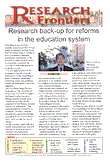 |
a rubber soil block

Principal Investigator > Dr
Kin-Man Lee > Email > kinman@ust.hk
| Soil from rubber tyres helps ease landfill problem |
|
|||||
| Cross-section
of a rubber soil block |
 |
|||||
| A high-tech solution to recycling rubber tyres is being developed by researchers at The Hong Kong University of Science and Technology, and resulting in double benefit for the environment. Each year, more than one billion tyres are scrapped around the world with most ending up as landfill or dumped illegally. "For Hong Kong, this is a substantial environmental issue," says Principal Investigator Dr Kin-Man Lee. Working with a Hong Kong company, the HKUST researchers have developed a process of recycling tyres into rubber soil for use in civil engineering work such as road widening, land reclamation, and the building of embankments, retaining walls and slopes. The researchers' rubber soil blocks have many advantages over compacted soils; they are lighter, stronger, permeable, energy absorbing, flexible for construction, and dust free. Until now, scrap tyres used in geotechnical work have usually been shredded, and mixed with soil, said Dr Lee. Quality and performance, especially without extracting metal reinforcement material, is inconsistent. The HKUST researchers, however, have devised a low-cost technique for extracting steel wires and formulating "soil" blocks from rubber crumbs, pulverised fly ash, Portland cement, polymer fibre and elastic binder. The resulting material is about half the weight of conventional compacted soil which reduces structural loadings and results in cost savings. The new soil is also highly porous, eliminating water pressure build-up, and has five to 10 times the compressive strength of compacted granular soils. | ||||||
|
Principal Investigator > Dr
Kin-Man Lee > Email > kinman@ust.hk
|
||||||